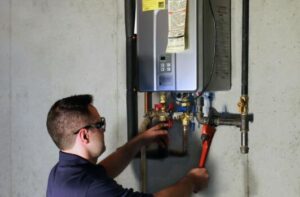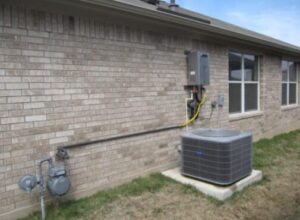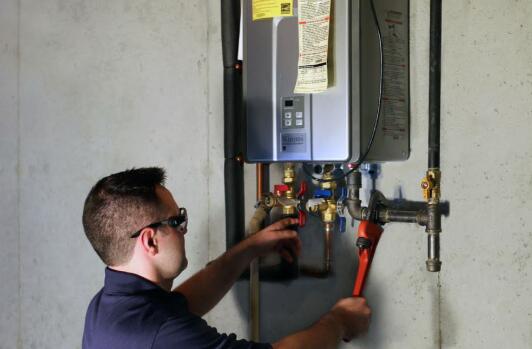The tankless water heater, also called an on-demand water heater, can save you capital since it does not store a large amount of water. However, it ensures that it generates hot water that is on-demand so that you do not need to worry about your shower running cold. On the other hand, it can only heat a given volume of water at a single time. The determinant factor of the hot-fixtures it can serve at a go depends on unit heating capacity. Note that tankless water heater installation requires excellent plumbing skills, while local codes might need a professional licensed plumber to perform the duty. This article will make you informed on how to install a whole-house tankless water heater.
There are a variety of basic options when it comes to tankless water heater options. These are:
Types of Whole House Tankless Water Heaters
Electric Tankless Water Heater
An electric tankless water heater that is indoor does not require a vent on the outside; instead, it needs you to have 240-volt energy plugged indirectly or in an outlet volt of 240 wired to your service panel.
Gas Powered Tankless Water Heater
A gas-powered tankless water heater must have a vent on the outside part. It also needs a fixation to a circuit of 120-volt. It can function if plugged in the outlet or directly wired to your service panel.
There are several ways to guide you on installing your house tankless water heater. These are:
The Preparation of Installing Whole House Tankless Water Heater
Before you commence installing, ensure you do all preparation necessary for installation. It is appropriate that you remove your previous water heater to serve on time. On the other hand, if you are installing a new gas unit, examine if you require the gas meter upgraded since you gas functions with a lot of BTUs. This means it can lack sufficient capacity to serve you other gas appliances at your home.
Ideally, the gas company can examine for you and upgrade it at either a zero cost or little. It should also examine the manifold to ensure it supplied enough amount for the new unit. In case there is a need to install a new gas line, ensure you get an expert plumber. Bear in mind that an indoor gas unit needs venting. The professional plumber can best conduct this since he might be aware of all the plumbing requirements.

When dealing with the electric water heater, as mentioned earlier, you need electrical energy of 240-volt. If you have electrical skills, you can do it yourself, but it is appropriate that you find an electrician to help you out. Codes may require subpanel installed close to your unit. Furthermore, it has its circuit breaker to enable you to disconnect energy to your unit if necessary easily.
Get rid of the old water heater
In many cases, tankless units that are new usually switch the storage water heater. To remove the water heater, ensure that you switch off the valves on the dual water lines that lead to your old water heater. Using a pipe wrench or pliers disconnect the water line from your water heater. Drain the tank by opening the drain valve. When you are on the gas unit, make sure you switch off the gas line’s valve to disconnect the gas line successfully. After disconnecting, eliminate two or a section of your vent pipe.
Use the electrician to disconnect your wiring and prevent electrocution from emerging. If you want to accomplish it yourself, make sure the circuit is, and the source of power is off. When you are through, disconnect wires from your unit and eliminate the old water heater.
Install a tankless water heater
You can install your new unit flush against your drywall or plaster it on the wall. Ideally, you can use a stud finder for studs’ location for cutting a hole in between. Use the manual script to attach your new tankless water heater. After that, fix the pipe for water supplying on your water heater. The water utility pipes channels to the inlet, and finally to your pipe channeling to your house is fixed on the outlet. On all lines, connect the shutoff valves. Moreover, you can add the valve for pressure relief. After that, make the final connection using union fittings, specifically the inlet and outlet.
When you are through open your water valves, but make sure you do not switch on the gas or electricity. Open the faucets in your house to examine if the water is running through your unit for approximately a minute, then switch off. Please get rid of the inline filter close to the inlet as you clean debris around it. Do the filter replacement, once more open your water valves, then restore your electrical power as you switch on the gas. Finally, examine if it is functioning efficiently.
How to Replace 55 Gallon Whole House Water Heater with Whole Tankless House?

Most of the time, you are required to consider federal regulations impacting the water heater. Therefore, if your gas water heater is 55 gallons and above, you are needed to install a tankless water heater with an efficiency of approximately 82%. Note that this rating is only in the tankless water heater and a few less well examined condensing tankless water heater.
Additionally, a tankless water heater generates endless water; it is useful for homes or prominent families with much hot water demands. In case you home have a spa system or a soaking tub, it is appropriate that you have a tankless water heater system. To replace 55-gallon whole house water heater with a whole tankless house, follow the procedure below:
- Get rid of your old heater.
- Make sure you install a new gas line.
- Install new water lines.
- Mount your water heater.
- Fix your water heater.
- Ensure you install the vent appropriately.
- Switch on your water heater.
Conclusion
Based on the above information, you are now familiar with installing a whole-house tankless water heater. Therefore, thanks to the procedure mentioned above for making the tankless water heater installation easy. It calls upon you to implement the procedure above and install your tankless water heater appropriately. I hope this article will keep you more informed in better understanding how to install a whole-house tankless water heater.


